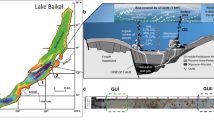Abstract
The denitrifying activity was measured in different types of sediment from the Mediterranean coast of France before, and after, a massive contamination (30–100 g kg-1 sediment) of hydrocarbons. A closed system was used in order to maintain anoxic conditions and to control substrates and gaseous products concentrations. We have demonstrated that the respiratory metabolism was inhibited in all cases following an incubation time of 20 to 50 days. At this time, the addition of lactate restore the denitrifying activity. The inhibitory effect of crude oil was not related to an alteration of bacterial cells, but to changes in environmental conditions allowing denitrification. The presence of hydrocarbons in the sediments causes a decrease in the redox potential and a concomitant stimulation of the sulfate reduction.
Similar content being viewed by others
References
Balderston WL, Sherr B & Payne WJ (1976) Blockage by acetylene of nitrous oxide production in Pseudomonas perfectomarinus. Appl. Environ. Microbiol. 81: 504–508
Bendschneider K & Robinson RJ (1972) A new spectrometric method for determination of nitrite in sea water. J. Marine Res. 11: 87–96
Chan YK & Knowles R (1979) Measurement of denitrification in freshwater sediments by an in situ acetylene inhibition method. Appl. Environ. Microbiol. 37: 1067–1072
Delaune RD, Patrick WH & Buresh RJ (1979) Effect of crude oil on a Louisina Spartina alterniftora salt marsh. Environ. Pollut 25: 21–31
Griffiths RP, Caldwell BA, Broich WA & Morita RY (1982) The long-term effects of crude oil on microbial processes in subarctic marine sediments. Estuar. Coast Shelf Sci. 15: 183–198
Haines JR, Atlas RM, Griffiths RP & Morita RY (1981) Denitrification and nitrogen fixation in Alaskan continental shelf sediments. Appi. Environ. Microbiol. 41: 412–421
Henrichs SM & Reeburgh WS (1987) Anaerobic mineralization of marine sediment organic matter: Rates and the role of anaerobic processes in the oceanic carbon economy. Geomicrobiol. J. 5: 191–237
Jenneman GE, McInerney MJ & Knapp RM (1986) Effect of nitrate on biogenic sulfide production. Appl. Environ. Microbiol. 51: 1205–1211
Jørgensen BB & Fenchel T (1974) The sulfur cycle of a marine sediment model system. Mar. Biol. 24: 189–201
Jørgensen BB (1978) A comparison of methods for the quantification of bacterial sulphate reduction in coastal marine sediments. I. Measurements with radiotracer techniques. Geomicrobiol. J. 1: 11–28
MacAulife L (1971) GC determination of solutes by multiple phase equilibration. Chem. Technol. 1: 46–51
Mille G, Mulyono M, El Jammal T & Bertrand JC (1988) Effects of oxygen on hydrocarbon degradation studies in vitro in superficial sediments. Estuar. Coast Shelf Sci. 27: 283–295
Mills AI, Briull C & Colwell RR (1978) Enumeration of petroleum degrading marine and estuarine microorganisms by the most probable number method. Can. J. Microbiol. 24: 552–557
Oppenheimer C & Zobell CE (1952) The growth and viability of sixty-three species of marine bacteria as influenced by hydrostatic pressure. J. Mar. Res., 11: 10–18
Pfaender FK & Buckley EN (1984) Effect of petroleum on microbial communities. In: Atlas RM (Ed) Petroleum Microbiology (pp 507–536). Macmillan Publishing Company, New York
Saliot A (1981) Natural hydrocarbons in sea water. In: Duursma EK & Dawson R (Eds) Marine Organic Chemistry (pp 327–374). Elsevier Scientific Publishing Company, Amsterdam
Slawick G & MacIsaac JJ (1972) Comparison of two automate ammonium method in a region of coastal upwelling. Deep Sea Res. 19: 521–524
Sorensen J, Jorgensen BB & Revsbech NP (1979) A comparison of oxygen, nitrate and sulfate respiration in coastal marine sediments. Microbial. Ecol. 5: 105–115
Treguer P & Le Corre P (1975) Manuel d'analyse des sels nutritifs dans l'eau de mer. Laboratoire d'Océanologie chimique, Université de Bretagne Occidentale, Brest, France, 110 p
Walsh JJ, Premuzi ET & Whiteledge TE (1981) Fate of nutrient enrichment on continental shelves as indicated by the C/N content of bottom sediments. Elsevier Oceanographic Series 32: 13–49
Author information
Authors and Affiliations
Rights and permissions
About this article
Cite this article
Bonin, P., Gilewicz, M., Rambeloarisoa, E. et al. Effect of crude oil on denitrification and sulfate reduction in marine sediments. Biogeochemistry 10, 161–174 (1990). https://doi.org/10.1007/BF00002228
Accepted:
Issue Date:
DOI: https://doi.org/10.1007/BF00002228




